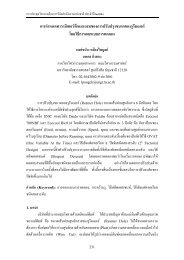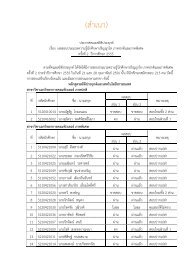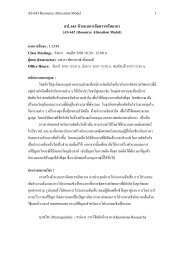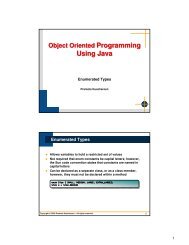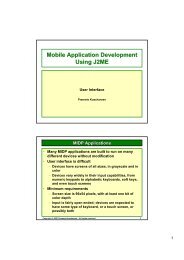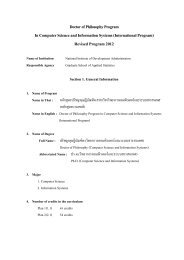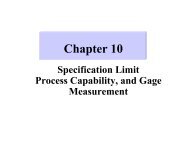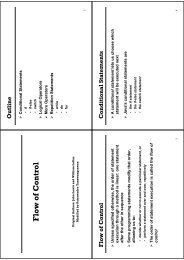ดาวน์โหลด All Proceeding - AS Nida
ดาวน์โหลด All Proceeding - AS Nida
ดาวน์โหลด All Proceeding - AS Nida
You also want an ePaper? Increase the reach of your titles
YUMPU automatically turns print PDFs into web optimized ePapers that Google loves.
44<br />
การประชุมวิชาการดานการวิจัยดําเนินงานแหงชาติ ประจําป 2554<br />
วันที่<br />
8-9 กันยายน 2554 ณ โรงแรม เอส ดี อเวนิว กรุงเทพฯ<br />
Meandering Improvement of Stealth Laser Dicing Process via<br />
Mixed Integer Linear Constrained Response Surface Optimization Model<br />
Wanwisa Sayrasang 1 and Pongchanun Luangpaiboon 2<br />
1, 2<br />
Industrial Statistics and Operational Research Unit (ISO-RU),<br />
Department of Industrial Engineering, Faculty of Engineering, Thammasat University, Pathumthani, Thailand<br />
Tel: 025643002-9 Ext 3081 Fax: 025643017 E-mail: 1 swanwisa@windowslive.com, 2 lpongch@engr.tu.ac.th<br />
Abstract<br />
This paper presents a collection of experimental design and<br />
mathematical programming techniques for meandering quality<br />
improvement in the stealth laser dicing process. The customer<br />
specification of the tolerance of meandering data has to be less than five<br />
microns with the target of zero microns. Currently the meandering data<br />
is slightly higher than the customer specification. This situation leads to<br />
a quality inspection with a large sample size with a high frequency. This<br />
brings the high level of production cost and also time and labors.<br />
Firstly, the 2 k factorial design was applied to preliminarily study the<br />
effects of those five process variables. The multiple regression models<br />
of those responses were then developed from only significant variables<br />
affecting the process response. Finally, the regression model in forms of<br />
the path of steepest descent was placed as the objective function of the<br />
linear constrained response surface optimizations model to meet the<br />
meandering target subject to the limitation from feasible ranges of<br />
significant variables. However, in this study there are some qualitative<br />
variables that need to be in forms of integer whereas the remains are<br />
quantitative. This mixed integer linear constrained response surface<br />
optimizations model provides the new operating conditions. The<br />
experimental results showed that it brings the meandering close to the<br />
target when compared or from 5.90 microns to 3.16 microns.<br />
Keywords: Stealth Laser Dicing Process, Meandering, Response<br />
Surface Methodology, Multiple Regression, Steepest<br />
Descent<br />
1. INTRODUCTION<br />
Dicing process is the process by which die are separated<br />
from a semiconductor wafer following the wafer processing. Chip<br />
carriers encapsulate individual silicon chips from the dicing process to<br />
use in building electronic devices. When wafers are diced, they are<br />
typically mounted on dicing tape to be able to hold the wafer on a thin<br />
sheet metal frame. Silicon wafers dicing may be performed by a laserbased<br />
technique or the stealth laser dicing process (SLDP). There are<br />
two stages on the process. Firstly, the beam from a pulsed laser with<br />
specific wavelengths is scanned along intended cutting lines. Defect<br />
regions are then introduced into the wafer with different depths.<br />
Secondly, an underlying carrier membrane is radically expanded to<br />
induce fracture. The cleavage initiates at the bottom. It advances to the<br />
surface and provides a high distortion density at the bottom.<br />
There some advantages of the stealth dicing process. Firstly,<br />
there is no requirement of a cooling liquid. Secondly, stealth dicing<br />
process hardly generates debris and it is possible to improve the wafer<br />
surface exploitation with a few level of loss when compared to wafer<br />
sawing. On the SLDP, the current level of meandering is still the main<br />
problem. The meandering measures are slightly higher than the<br />
customer specification. This situation leads to a quality inspection with<br />
a large sample size with a high frequency. This brings the high level of<br />
production cost and also time and labor. Therefore, the meandering<br />
quality in the SLDP needs to improve. With high technology machine,<br />
the problem has still existed. It is found that the process performance of<br />
defects is still quite high, as shown in Fig 1. In this case, the deep detail<br />
of stealth dicing process should be investigated so that the optimum<br />
working condition would be determined. Consequently, the problem of<br />
interest would be dissolved




